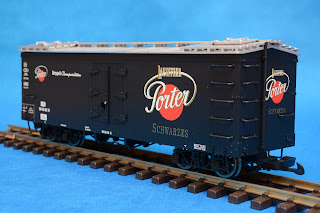There are of course different options available when converting a piece of rolling stock to digital protocol. But if you want to make it easy for yourself (and I do!), you just go for the dedicated electronics. In case of Piko Taurus that would be:
- Piko 36120 DCC decoder
- Piko 36190 sound module
The box the decoder comes in is exactly the same as for all other similar Piko products. The only difference is in the sticker in the right bottom corner.
The content is exactly what we would expect. We get:
- a decoder PCB with cabling
- a set of screws
- a set of instruction manuals
The packaging of the sound module is not a surprise either. The same purple cardboard box with a sticker indicating the type of the item inside.
After opening the box we find the following:
- a large loudspeaker
- a tiny piece of PCB (the actual sound module)
- installation instructions
- digital functions descriptions
First we need to open the Taurus. The schematics provided with the locomotive are very clear about the disassembly process. What's even more interesting, they offer a hint on how to perform that operation in a safe manner.
The trick is to use the original polystyrene mold that came with the model. We can place the locomotive upside down inside the part that normally acts as a top cover. This gives us access to the bottom of the engine while keeping all the roof details completely safe.
And it gets better! Once we remove the 10 relevant screws, we can move the chassis away and place it next to the still secured top element. The cables are long enough to allow comfortable work in this setup. Fantastic solution!
The bag containing the decoder screws holds also a few small electrical connectors. Those confused me a lot in the beginning. Turns out they're needed only in case of some older Taurus models. I will not be using them for my Piko 37428.
Wiring for the upgrade is not difficult but the connectors next to the bogies may be a challenge at first. The pins' functions may not be so clear. The puzzle is solved once we take a closer look. There are clear markings in the plastic but they are not visible right away, especially in poor lighting.
The decoder gets installed in its dedicated space. Fits perfectly.
Once all the wiring is done, we still have some leftover cables. That is fine. And of course we might find them useful one day in the future!
It's time to start testing. And I get a nasty surprise - it does not work. Roco Multimaus has some clear issues programming the decoder. I'm forced to reset it to the factory defaults and start from scratch. Luckily it's a success on the second try. Everything works...
...not. I have obviously made a mistake and wired the engines the wrong way. When one motor goes forward, the other goes backwards. I need to correct the polarization :)
Adding the sound module comes next. There's pleeeeeeeeenty of space inside the locomotive. The loudspeaker goes into its dedicated slot, and the PCB goes... anywhere. It's only important to secure it well.
The sound module requires no configuration. It just works. Here's a demo of the available functions:
Conversion to DCC and adding sound is an expensive procedure. Many people still believe this is not worth the price. From my point of view, the model gains A LOT as a result of the upgrade. I'm very happy with the outcome and I'm convinced my money was well spent. I'd encourage everyone who is still "behind" to take a leap of faith and finally go digital :)





























































